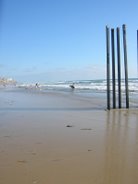| 7:45am | Wake up and get out of bed. Don't take a shower. Put on my dirty clothes from the day before. |
| 8:00am | Do an introduction with the volunteer group. Explain the work that we will be doing as well as some ground rules for the worksite and for the living facilities. |
| 8:30am | Leave for the worksite. A construction superviser and I are in a pickup full of tools. The volunteer group is following us. Poor road conditions, distance, and traffic account for the 1 hour morning commute. |
| 9:30am | We arrive at the worksite and I introduce the family and the volunteers to one another. This usually consists of the names and ages of the volunteers and a welcome by the family. Everyone is anxious to get started. |
| 9:45am | We begin working. We unload the tools from the truck bed and pass them out to volunteers. I direct traffic and get people started on specific tasks, i.e. I "coordinate volunteers." These tasks may consist of tying rebar, digging trenches, stacking blocks, making cement, passing cement, and more. |
| 1:00pm | Lunchtime. Lunch is cooked and served by members of the community. Lunch usually consists of rice, beans, tortillas, some form of meat, and agua (flavored water). I've been on this diet for over three months, and I still look forward to this food everyday. |
| 1:45pm | Start working again. It's often a little slow immediately after lunch (you can imagine why), but after about 1/2-hour, the group picks up the pace once more. |
| 3:00pm | Stop working. Just before the second wind is about to deflate, I direct the group to pick up the tools, clean up any materials we've been working with and get into their vehicles. "We're heading back to the Posada!" |
| 4:00pm | Get back to the Posada (beautiful living facility). Let the group shower and change their clothes while we unload the tools and work on some other projects in the office or in the field. There's quite a bit of administrative work that we need to do to prepare for upcoming groups and to follow up on groups that already came. In addition, I've got some projects on my own to work on during this time. |
| 5:30pm | Clean up. Maybe take a shower and change clothes. |
| 6:00pm | Eat dinner. The volunteer group will usually invite me to eat with them. That means spaghetti or something else easy to cook for 30+ people. |
| 7:00pm | Group activity. This may involve taking a group for a trip to the dUS-Mexico border, going to the Tijuana cultural center, visiting Rosarito to do some touristy shopping, going to a soccer game, etc. |
| 10:00pm | Personal time. I try to read and/or do some e-mail correspondences although I usually end up falling asleep in the process. |
| 11:00pm | Go to bed. Zzzzzz..... |
There is a lot of flexibility in this schedule, accounted for by the fact that there are two other people working with me. One, Eduardo Zavala has been doing this for seven years, and the other, Valentin Claudel, is a volunteer from the Brittany region of France.
In general we have at least 30 volunteers in a facility that can hold up to 64. This pattern will change as summer draws nearer and we will be double-, triple-, and even quadruple-booked. That means less and less time to do personal stuff like bathe, sleep, and eat. Am I complaining? Naw...I can't wait for the summer season.
Currently reading: "Thinking in Pictures and Other Reports from My Life with Autism" by Temple Grandin
Currently listening to: Los Fabolosos Cadillacs, Los Tigres del Norte, and Sergio Vega.

